Things to Come
6.9 /10 2 Votes6.8
Screenplay H. G. Wells Country United Kingdom | 6.8/10 IMDb Genre Sci-Fi Duration Language English | |||||||||||||||||||||||||||||||||
 | ||||||||||||||||||||||||||||||||||
Release date 20 February 1936 (1936-02-20) Based on The Shape of Things to Come by H. G. Wells Writer H.G. Wells (novel), H.G. Wells (screenplay) Cast (John Cabal / Oswald Cabal), (Pippa Passworthy / Raymond Passworthy), (The Boss), (Theotocopulos), (Roxana / Rowena), (Dr. Harding) Similar movies Interstellar , The Hunger Games: Mockingjay - Part 1 , Fury , Chappie , Avatar , Captain America: Civil War Tagline The future is here! | ||||||||||||||||||||||||||||||||||
Things to come 1936 trailer
Its Christmas 1940, and Everytown resident John Cabal (Raymond Massey) fears that war is imminent. When it breaks out, the war lasts 30 years, destroying the city and ushering in a new dark age of plagues and petty despots. But there is hope in the form of Wings Over the World, a group of pacifist scientists and thinkers lead by Cabal. Their dream is to build a utopian society on the ruins of the old. But first theyll have to unseat the latest ruling tyrant (Ralph Richardson).
Contents
- Things to come 1936 trailer
- Things to come 1936 hg wells
- Plot
- Cast
- Production
- Historical parallels
- Reception
- Duration history and surviving versions
- Similar Movies
- Copyright status
- References

Things to Come (1936) is a British science fiction film written by H. G. Wells, produced by Alexander Korda and directed by William Cameron Menzies. The film stars Raymond Massey, Ralph Richardson, Cedric Hardwicke, Pearl Argyle and Margaretta Scott. The cultural historian Christopher Frayling calls Things to Come "a landmark in cinematic design."

The dialogue and plot were devised by H. G. Wells as "a new story" meant to display the "social and political forces and possibilities" that he had outlined in his 1933 story The Shape of Things to Come, a work he considered less a novel than a "discussion" in fictional form that presented itself as the notes of a 22nd-century diplomat. The film was also influenced by previous works, including his 1897 story "A Story of the Days to Come" and his 1931 work on society and economics, The Work, Wealth and Happiness of Mankind; speculating on the future had been a stock-in-trade for Wells ever since The Time Machine (1895).
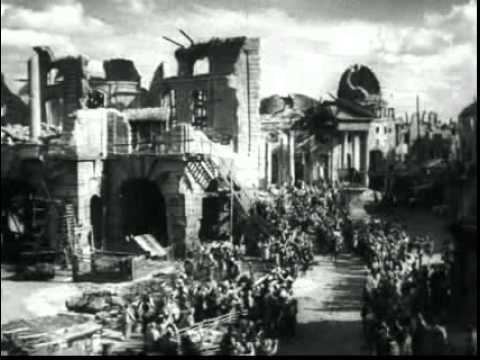
Late 1960 and the world consists of feudal cities after decades of a global war and plague. 2035 and the world has been rebuilt with fantastic technology, but has progress gone too far and has man learned anything.
Things to come 1936 hg wells
Plot

Things to Come sets out a future history from 1940 to 2036. In the screenplay, or "treatment" that Wells published in 1935, before the film was released, the story ends in the year "A.D. 2054". It is set in the fictional British city of Everytown. Successful businessman John Cabal (Raymond Massey) cannot enjoy Christmas Day, 1940, with the ominous news of possible war. His guest, Harding (Maurice Braddell), shares his worries, while his other friend, the over-optimistic Passworthy (Edward Chapman), believes it will not come to pass – or even if it does, it will do good by accelerating technological progress. A bombing raid on the city that night results in general mobilisation and global war.
Some time later, Cabal, now piloting a biplane, shoots down a one-man enemy bomber. He lands and pulls the badly injured enemy (John Clements) from the wreckage. As they dwell on the madness of war, they have to put on their gas masks, as poison gas drifts in their direction. When a little girl runs towards them, the wounded man insists she take his mask, saying he is done for anyway. Cabal takes the girl to his aeroplane, pausing to leave the doomed man a revolver. The man dwells on the irony that he may have gassed the childs family and yet he has saved her. He then shoots himself.
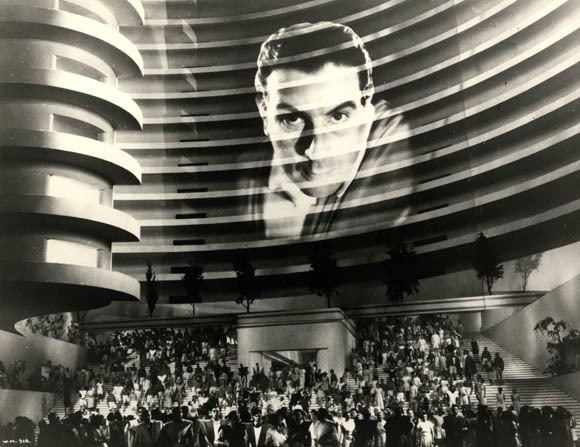
The war continues into the 1960s, long enough for the people of the world to have forgotten why they are fighting in the first place. Humanity enters a new Dark Age. The world is in ruins and there is little technology left apart from the firearms used to wage war. In 1966, a biological weapon called the "wandering sickness" is used by the unnamed enemy in a final desperate bid for victory. Dr. Harding and his daughter Mary struggle to find a cure, but with little equipment, it is hopeless. The plague kills half of humanity and extinguishes the last vestiges of central government.
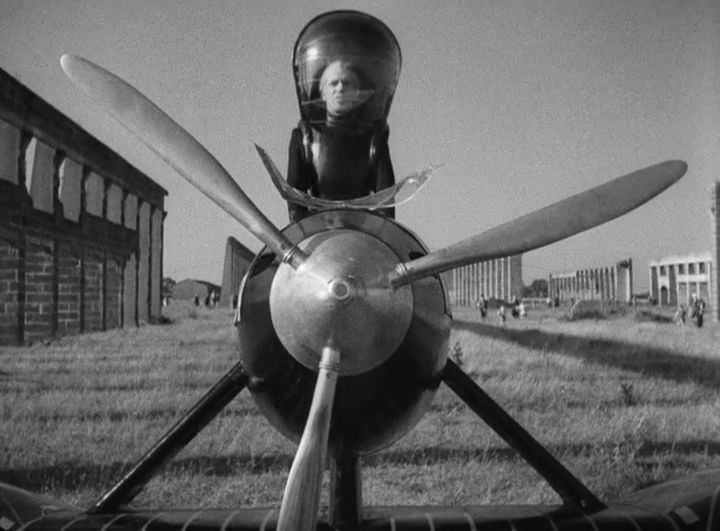
By 1970, a local warlord called the "Chief" or the "Boss" (Ralph Richardson) has risen to power in southern England and eradicated the sickness by shooting the infected. He dreams of conquering the "hill people" to obtain coal and shale to render into oil so his biplanes can fly again.
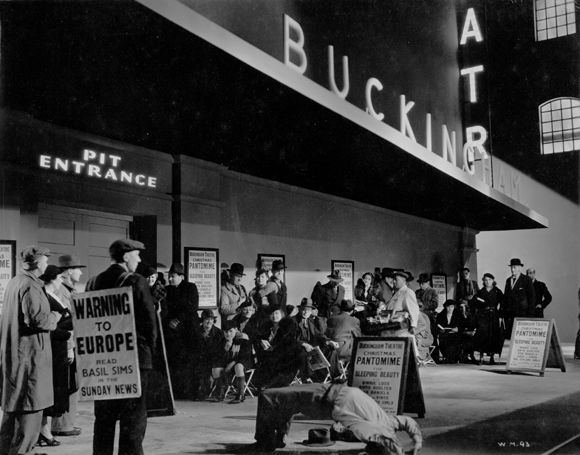
On May Day 1970, a futuristic aeroplane lands outside the town. The sole pilot, John Cabal, emerges and proclaims that the last surviving band of "engineers and mechanics" have formed a civilisation called "Wings Over the World". They are based in Basra, Iraq, and have renounced war and outlawed independent nations. The Boss takes the pilot prisoner and forces him to work for Gordon, a mechanic working on repairing the few remaining aeroplanes. Together, they manage to fix a plane. When Gordon takes it up for a test flight, he flees to alert Cabals friends.
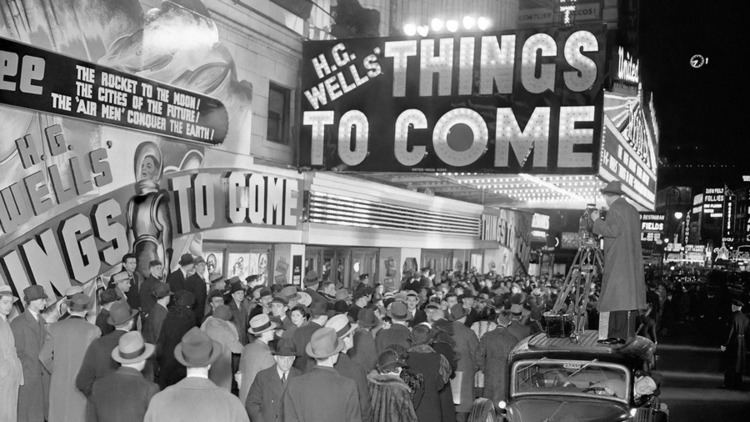
Gigantic aeroplanes arrive and start dropping sleeping gas bombs on the town. The Boss orders his biplanes to attack, but they are shot down. The people of Everytown awaken shortly thereafter, to find themselves under the rule of Wings Over the World, and the Boss dead from an unexpected reaction to the gas.
A montage follows, showing decades of technological progress, beginning with Cabal explaining plans for global consolidation by Wings Over the World. By 2036 (2054 in the book), mankind lives in modern underground cities, including the new Everytown.

However, all is not well. The sculptor Theotocopulos (Cedric Hardwicke) incites the populace to demand a "rest" from the rush of progress, symbolised by the first manned flight around the Moon. The modern-day Luddites are opposed by Oswald Cabal (Massey again), the head of the governing council and grandson of John Cabal. Oswald Cabals daughter Catherine (Pearl Argyle) and her boyfriend Horrie Passworthy insist on flying the spaceship. When a mob rushes to destroy the space gun used to propel the spacecraft, Cabal launches the ship ahead of schedule.
At the conclusion of the film, Oswald Cabal delivers a speech about progress and humanitys quest for knowledge.
Cast
Production
Wells is sometimes incorrectly assumed to have had a degree of control over the project that was unprecedented for a screenwriter, and personally supervised nearly every aspect of the film. Posters and the main title bill the film as "H. G. Wells THINGS TO COME", with "an Alexander Korda production" appearing in smaller type. In fact, Wells ultimately had no control over the finished product, with the result that many scenes, although shot, were either truncated or not included in the finished film. The rough-cut reputedly ran to 130 minutes; the version submitted to the British Board of Film Censors was 117m 13s; it was released as 108m 40s (later cut to 98m 06s) in the UK, and 96m 24s in the United States (see below for later versions). Wellss script—or "film treatment"—and selected production notes were published in book form in 1935 and reprinted in 1940 and 1975. An academic edition annotated by Leon Stover was published in 2007. The script contains many scenes that were either never filmed or no longer exist, although the extant footage also includes scenes not in the published script (e.g. the Bosss victory banquet after the capture of the colliery).
Wells originally wanted the music to be recorded in advance, and have the film constructed around the music, but this was considered too radical and so the score, by Arthur Bliss, was fitted to the film afterwards in a more conventional way. A concert suite drawn from the film has remained popular; as of 2003, there are about half-a-dozen recordings of it in print.
After filming had already begun, the Hungarian abstract artist Laszlo Moholy-Nagy was commissioned to produce some of the effects sequences for the re-building of Everytown. Moholy-Nagys approach was partly to treat it as an abstract light show, but only some 90 seconds of material was used, e.g. a protective-suited figure behind corrugated glass. In the autumn of 1975 a researcher found a further four sequences which had been discarded.
The art design in the film is by Vincent Korda, brother of the director. The futuristic city of Everytown in the film is based on London: a facsimile of St Pauls Cathedral can be seen in the background.
Historical parallels
The film, written throughout 1934, is notable for predicting World War II, being only 16 months off by having it start on Christmas 1940, rather than 1 September 1939. Its graphic depiction of strategic bombing in the scenes in which Everytown is flattened by air attack and society collapses into barbarism, echo pre-war concerns about the threat of "the bomber will always get through". Wells was an air power prophet of sorts, having described aerial warfare in Anticipations (1901) and The War in the Air (1908).
The use of gas bombs is very much part of the film, from the poison gas used early in the war to the sleeping gas used by the airmen of Wings Over the World. In real life, in the build-up to the Second World War, there was much concern that the Germans would use poison gas, which was used by France, Germany and Great Britain during the Great War. Civilians were required to carry gas masks and were trained in their use. When war did break out, however, the Germans did not use gas for military purposes.
Wings Over the World is based in Basra, in southern Iraq, from where it begins a new civilisation. Southern Iraq was also the home of one of the worlds first known civilisations, Sumer, which began about 6,000 B.C. and invented the wheel, among a host of other things.
The single world government having engineers, scientists and inventors as the rulers mimics the ideology of the concept of technocracy, where those of the greatest skill and intellect in various vocations would be the leaders.
Reception
The film was voted the ninth best British movie of 1936.
Science fiction historian Gary Westfahl has stated: "Things to Come qualifies as the first true masterpiece of science fiction cinema, and those who complain about its awkward pace and uninvolving characters are not understanding Wellss message, which is that the lives and actions of individuals are unimportant when compared to the progress and destiny of the entire human race."
Duration history and surviving versions
The rough-cut of the film was 130 minutes in length, while the version submitted for classification by the British Board of Film Censors (BBFC) was 117m 13s. By the time of the 21 February 1936 UK premiere and initial release, this had been reduced to 108m 41s, while the American print premiered on 18 April 1936 was further cut to 96m 31s. By late 1936, a 98m 07s print was in circulation in the UK, and a 76m 07s print was resubmitted for classification by the BBFC and was passed – after further cuts – at 72m 13s for reissue in 1943. The 96m 31s American print was cut down to 93m 19s by the removal of three sections of footage for a reissue by British Lion Films in 1948, and then to 92m 44s subsequently by the removal of one more segment. A continuity script exists for a version of approximately 106m 04s, which contains all the material in the 96m 31s and 92m 44s versions, plus a number of other sequences. It is not known if a version of this duration was actually in circulation at any time.
For many years, the principal surviving version of the film was the 92m 44s print. From at least the late-1970s until 2007, this was the only version "officially" available from the rights holders in the UK, and has been widely available via home video and television screenings, both in the UK and elsewhere (in countries using PAL or SECAM video systems, it runs to 89m exactly).
In the United States, although the 92m 44s version is most prevalent, a version is also in circulation that includes the four pieces of footage that were in the 96m 31s print, but not the 92m 44s version, although due to cuts elsewhere, it actually runs shorter than the latter. A cut version of the 92m 44s print was digitally restored and colorised by Legend Films, under the supervision of Ray Harryhausen (who had no connection with the making of the film whatsoever), and released on DVD in the United States in early 2007.
In May 2007, Network DVD in the UK released a digitally restored copy of the 96m 31s version, which to date is the longest version available on DVD anywhere in the world. The two-disc set also contains a "Virtual Extended Version" with most of the missing and unfilmed parts represented by production photographs and script extracts. In 2011 Network released an updated and expanded version of this edition on Blu-ray in HD.
The Criterion Collection released a new version of the 96m 31s print on DVD and Blu-ray in North America on 18 June 2013. This includes the unused Moholy-Nagy footage as an extra.
Similar Movies
H G Wells wrote the screenplay for Things to Come and wrote the story for H G Wells The Shape of Things to Come. H G Wells wrote the screenplay for Things to Come and The Man Who Could Work Miracles. H G Wells wrote the screenplay for Things to Come and wrote the story for The Time Machine. H G Wells wrote the screenplay for Things to Come and wrote the story for First Men in the Moon. Ralph Richardson appears in Things to Come and The Lion Has Wings.
Copyright status
Although the film lapsed into the public domain in the United States in 1964, copyright remained in force in the UK, the European Union, and elsewhere. In the UK, copyright for films as "dramatic works" subsists for seventy years after the end of the year of release, or the death of either the director, the writer (or author of original story), or the composer of original music, whichever is the latest. As the composer, Arthur Bliss, did not die until 1975, copyright will not expire until after 31 December 2045. The current copyright holder is ITV Global Entertainment Ltd., while the longest surviving original nitrate print is held by the BFI National Archive, a copy of the 96m 31s print donated by London Films to the newly formed National Film Archive in March 1936.
The film came back into copyright in the United States in 1996 under the Uruguay Round Agreements Act (URAA), which, among other measures, amended US copyright law to reinstate copyright on films of non-US origin if they were still in copyright in their country of origin. The URAA was subsequently challenged in Golan v. Gonzales, initially unsuccessfully, later with partial success, but the challenge was ultimately defeated in Golan v. Holder and a new principle established that international agreements could indeed restore copyright to works which had previously come into the public domain.
References
Things to Come WikipediaThings to Come IMDb Things to Come themoviedb.org
